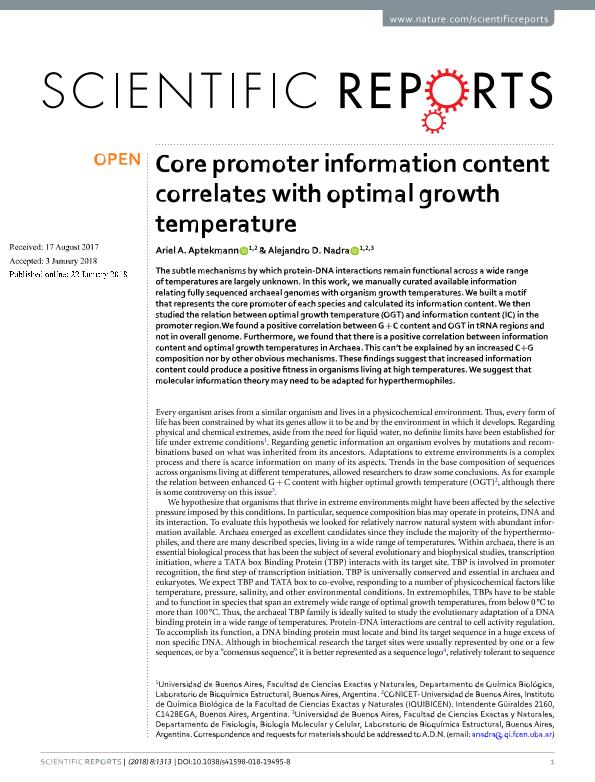Mostrar el registro sencillo del ítem
dc.contributor.author
Aptekmann, Ariel

dc.contributor.author
Nadra, Alejandro Daniel

dc.date.available
2020-01-08T21:38:39Z
dc.date.issued
2018-12
dc.identifier.citation
Aptekmann, Ariel; Nadra, Alejandro Daniel; Core promoter information content correlates with optimal growth temperature; Nature Publishing Group; Scientific Reports; 8; 1313; 12-2018; 1-7
dc.identifier.issn
2045-2322
dc.identifier.uri
http://hdl.handle.net/11336/94066
dc.description.abstract
The subtle mechanisms by which protein-DNA interactions remain functional across a wide range of temperatures are largely unknown. In this work, we manually curated available information relating fully sequenced archaeal genomes with organism growth temperatures. We built a motif that represents the core promoter of each species and calculated its information content. We then studied the relation between optimal growth temperature (OGT) and information content (IC) in the promoter region.We found a positive correlation between G + C content and OGT in tRNA regions and not in overall genome. Furthermore, we found that there is a positive correlation between information content and optimal growth temperatures in Archaea. This can't be explained by an increased C+G composition nor by other obvious mechanisms. These findings suggest that increased information content could produce a positive fitness in organisms living at high temperatures. We suggest that molecular information theory may need to be adapted for hyperthermophiles.
dc.format
application/pdf
dc.language.iso
eng
dc.publisher
Nature Publishing Group

dc.rights
info:eu-repo/semantics/openAccess
dc.rights.uri
https://creativecommons.org/licenses/by-nc-sa/2.5/ar/
dc.subject
INFORMATION CONTENT
dc.subject
ARCHAEA
dc.subject
TBP
dc.subject
GC CONTENT
dc.subject.classification
Biofísica

dc.subject.classification
Ciencias Biológicas

dc.subject.classification
CIENCIAS NATURALES Y EXACTAS

dc.title
Core promoter information content correlates with optimal growth temperature
dc.type
info:eu-repo/semantics/article
dc.type
info:ar-repo/semantics/artículo
dc.type
info:eu-repo/semantics/publishedVersion
dc.date.updated
2019-10-24T19:35:19Z
dc.journal.volume
8
dc.journal.number
1313
dc.journal.pagination
1-7
dc.journal.pais
Reino Unido

dc.description.fil
Fil: Aptekmann, Ariel. Universidad de Buenos Aires; Argentina. Consejo Nacional de Investigaciones Científicas y Técnicas. Oficina de Coordinación Administrativa Ciudad Universitaria. Instituto de Química Biológica de la Facultad de Ciencias Exactas y Naturales. Universidad de Buenos Aires. Facultad de Ciencias Exactas y Naturales. Instituto de Química Biológica de la Facultad de Ciencias Exactas y Naturales; Argentina
dc.description.fil
Fil: Nadra, Alejandro Daniel. Universidad de Buenos Aires; Argentina. Consejo Nacional de Investigaciones Científicas y Técnicas. Oficina de Coordinación Administrativa Ciudad Universitaria. Instituto de Química Biológica de la Facultad de Ciencias Exactas y Naturales. Universidad de Buenos Aires. Facultad de Ciencias Exactas y Naturales. Instituto de Química Biológica de la Facultad de Ciencias Exactas y Naturales; Argentina
dc.journal.title
Scientific Reports
dc.relation.alternativeid
info:eu-repo/semantics/altIdentifier/url/http://www.nature.com/articles/s41598-018-19495-8
dc.relation.alternativeid
info:eu-repo/semantics/altIdentifier/doi/http://dx.doi.org/10.1038/s41598-018-19495-8
Archivos asociados
